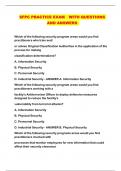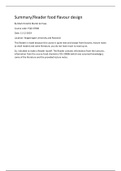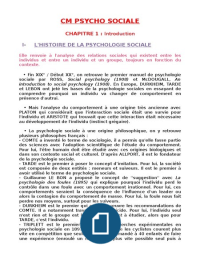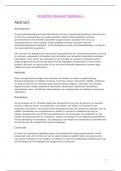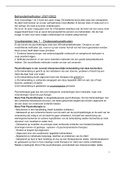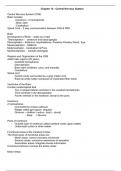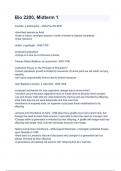Lecture 1 | 28 January 2019
Resources
Resources are inputs, those things that go in the production of goods and services, and generally they can be divided
into three categories:
1. Natural resources i.e. all the stuff we get from nature to sustain our modern existence (e.g. fossil fuels,
minerals, agricultural land, forests, water, the air. Natural resources are sometimes called “land”
2. Human resources, e.g. entrepreneurs, accountants, farmers, lawyers, cleaners etc.
3. Manmade resources e.g. machinery, aircraft, computers, plastics, glass, silicon, chemicals
Division of Labor
Why does division of labor exist and why are we breaking complex production processes into a number of simple
tasks with different individuals specializing in different tasks? According to Adam Smith, it is because division of
labor greatly increases efficiency, as well as productivity. How exactly does division of labor help to improve
productivity? David Ricardo believes that specialization of labor takes advantage of workers with different skills. By
having its workers specializing in jobs that they had comparative advantage in, the productivity could be maximized,
because when every person is doing what they’re best at doing, we can make to most out of every single unit of labor.
Adam Smith, on the other hand, thinks that even if every worker had the same set of skills and talents, specialization
of labor can still boost productivity. In his famous analysis of a paint factory, Smith claimed that by having different
workers specializing in every single component of the production process, time taken for workers to acquire new skills
and switch tasks could be saved.
Division of labor: splitting of tasks into their component parts and having these performed separately. It is a natural
phenomenon in human society. Specialization is the cause of also the consequence of division. Division of labor leads
to increases in productivity, because (1) there is an increase in dexterity, (2) time spent on switching the tasks is saved,
and (3) the invention of machines. These are examples of economies of specialization.
Transaction = exchange. Transactions lead to need of coordination.
Markets
• An abstract space where parties engage in exchange
• Parties can exchange goods by barter or by exchange for money (money itself is not a resource)
• Competitive feature of the marker (at least 2 buyers and 1 seller, or 1 buyer and 2 sellers)
• Ideal market: price-mechanism as sufficient statistics
• Place where demand and supply meet
• Market mechanism matches demand with supply for certain price
• Coordination between producers and consumers > through interaction in the marker
Organizations
If markets are efficient, why do we need organizations? According to R. Coase this is because of the nature of the
firms costs for using the price system. There are (1) costs for finding out the relevant information, (2) costs for
creating contracts, and (3) costs of bargaining. Organizations provide an alternative:
• The price system as coordination mechanism is supplemented with authority
• Some transaction costs that appear in the market are internalized and thus reduced
• Organization however produce transaction costs of their own
Organization vs. Market
• Coordination mechanisms
• Manner in which information are communicated among parties.
• In a market: price as sufficient statistics
, • In an organization: internal authority
Environment
• Provides conditions for creation of markets and organization
• Shapes organizations and market by exerting social, economic and political pressures.
• Ultimate selection mechanism for determining which organizations and markets survive
Institutions
• Formal and informal rules developed within society
• Any structure or mechanism shaping the behavior of individuals within given society
• Institutions are part of the environment
• Formal institutions and their enforcement expanded due to expansion of markets
• Personal exchange became impersonal exchange
• Impersonal exchange offered space to fraud and malevolent behavior
• Example: disclosure requirements of public companies
Lecture 2 | January 30
What is an organization?
“An organization is a structured social system consisting of groups and individuals working together to meet some
agreed objectives.” (Greenfield & Baron, 2003). “Every organized human activity… gives rise to two opposing things:
the division of labor into various tasks to be performed and the coordination of these tasks to accomplish the activity.
The structure of an organization can be defined simply as the sum total of the ways in which it divides its labor into
distinct tasks and then achieves coordination among them.” (Mintzberg, 1979: 2).
Various types of coordination mechanisms
There are a number of coordinating mechanisms that explain the fundamental ways for organizations to coordinate
their work:
• Mutual adjustment
o Achieves coordination of work by simple process of informal
communication within an organization
o Control of the work rests in the hands of doers
o Can be used form simplest to most complicated organizations.
• Direct supervision
o Achieves coordination by having one person taking responsibility of the work of others, issuing
instructions to them and monitoring their actions.
o To be used in simple organizations
Standardization
• When coordination is incorporated in the program upon its
establishment, the need for continuous coordination will also be
reduced accordingly.
• Standardization of work progress
o Work process is standardized when contents of work are specified or
programmed
• Standardization of outputs
, o Outputs are standardized when the results of work are specified
• Standardization of skills (or: of outputs)
o Skills are standardized when some training is specified as a prerequisite for performing the work
• Standardization of norms
o Norms are standardized when they are controlled
A continuum among the coordinating mechanisms
As organizational work becomes more complicated, the favored means of coordination would shift from mutual
adjustment to direct supervision, to standardization, finally reverting back to mutual adjustment.
Basic parts of organizations
• Six basic parts of organizations
o The operating core:
▪ Those that provide the basic work of the organization
▪ The heart of every organization
▪ Four primary functions
• Secure inputs
• Transform into outputs
• Distribute outputs
• Provide direct support to the previous functions
o The administrative component
▪ The strategic apex
• Those managers at the very top of the hierarchy
• Carries three sets of duties to make sure the organization serves its mission
effectively
o Carry out direct supervision
o Manages relationship between the organization and its environment
o Develops organization strategy
▪ The middle line
• Those that join the strategic apex to the operating core
• Include all levels of managers from below the strategic apex to first-line supervisors
• Performs all the managerial roles of the chief executive but in the context of his own
unit
• Direct supervision + mutual adjustment
o Vertically
o Horizontally
o Outside the operating work flow
▪ The technostructure
• Carry out the work of standardization by applying their analytical techniques to make
the work of others more effective.
, • Such as engineers and planners (who standardize work processes), accountants (who
standardize outputs), and trainers and recruiters (who standardize work skills)
• Can be present at all levels of organization hierarchy
▪ The support staff
• Supports the functioning of the operating core indirectly
• Such as legal counsel, public relations
• Can be present at all levels of organization hierarchy
▪ The ideology
• A system of values and beliefs of an organization shared by its members and
distinguishes it from other organizations
• Design of decision-making system
• Centralization vs decentralization of decision-making powers
• Why decentralize?
o Because all decision cannot be understood at one center
o Because it allows an organization to respond quickly to local conditions
o Because it is a stimulus for motivation
Types of organizations
• Six organizational configurations
Organizational Configuration Prime coordinating mechanism Key part of organization
Entrepreneurial organization Direct supervision Strategic apex
Machine organization Standardization of work processes Techno-structure
Professional organization Standardization of skills Operating core
Diversified organization Standardization of outputs Middle line
Innovative organization Mutual adjustment Supporting staff
Missionary organization Standardization of norms Ideology
• Entrepreneurial organization
o Non-sophisticated technical system
o Loose division of labor
o Little formalization and standardization
o Centralized decision-making, with flexibility and adaptability
o Owner-managed
o Typical variants:
▪ New organization or small organization
▪ Crisis organization
▪ Autocratic/charismatic organization – sense of mission
o The riskiest structure
• Machine organization
o Tasks are simple and repetitive at the operating core, little discretion
o Vertical and horizontal job specialization
Resources
Resources are inputs, those things that go in the production of goods and services, and generally they can be divided
into three categories:
1. Natural resources i.e. all the stuff we get from nature to sustain our modern existence (e.g. fossil fuels,
minerals, agricultural land, forests, water, the air. Natural resources are sometimes called “land”
2. Human resources, e.g. entrepreneurs, accountants, farmers, lawyers, cleaners etc.
3. Manmade resources e.g. machinery, aircraft, computers, plastics, glass, silicon, chemicals
Division of Labor
Why does division of labor exist and why are we breaking complex production processes into a number of simple
tasks with different individuals specializing in different tasks? According to Adam Smith, it is because division of
labor greatly increases efficiency, as well as productivity. How exactly does division of labor help to improve
productivity? David Ricardo believes that specialization of labor takes advantage of workers with different skills. By
having its workers specializing in jobs that they had comparative advantage in, the productivity could be maximized,
because when every person is doing what they’re best at doing, we can make to most out of every single unit of labor.
Adam Smith, on the other hand, thinks that even if every worker had the same set of skills and talents, specialization
of labor can still boost productivity. In his famous analysis of a paint factory, Smith claimed that by having different
workers specializing in every single component of the production process, time taken for workers to acquire new skills
and switch tasks could be saved.
Division of labor: splitting of tasks into their component parts and having these performed separately. It is a natural
phenomenon in human society. Specialization is the cause of also the consequence of division. Division of labor leads
to increases in productivity, because (1) there is an increase in dexterity, (2) time spent on switching the tasks is saved,
and (3) the invention of machines. These are examples of economies of specialization.
Transaction = exchange. Transactions lead to need of coordination.
Markets
• An abstract space where parties engage in exchange
• Parties can exchange goods by barter or by exchange for money (money itself is not a resource)
• Competitive feature of the marker (at least 2 buyers and 1 seller, or 1 buyer and 2 sellers)
• Ideal market: price-mechanism as sufficient statistics
• Place where demand and supply meet
• Market mechanism matches demand with supply for certain price
• Coordination between producers and consumers > through interaction in the marker
Organizations
If markets are efficient, why do we need organizations? According to R. Coase this is because of the nature of the
firms costs for using the price system. There are (1) costs for finding out the relevant information, (2) costs for
creating contracts, and (3) costs of bargaining. Organizations provide an alternative:
• The price system as coordination mechanism is supplemented with authority
• Some transaction costs that appear in the market are internalized and thus reduced
• Organization however produce transaction costs of their own
Organization vs. Market
• Coordination mechanisms
• Manner in which information are communicated among parties.
• In a market: price as sufficient statistics
, • In an organization: internal authority
Environment
• Provides conditions for creation of markets and organization
• Shapes organizations and market by exerting social, economic and political pressures.
• Ultimate selection mechanism for determining which organizations and markets survive
Institutions
• Formal and informal rules developed within society
• Any structure or mechanism shaping the behavior of individuals within given society
• Institutions are part of the environment
• Formal institutions and their enforcement expanded due to expansion of markets
• Personal exchange became impersonal exchange
• Impersonal exchange offered space to fraud and malevolent behavior
• Example: disclosure requirements of public companies
Lecture 2 | January 30
What is an organization?
“An organization is a structured social system consisting of groups and individuals working together to meet some
agreed objectives.” (Greenfield & Baron, 2003). “Every organized human activity… gives rise to two opposing things:
the division of labor into various tasks to be performed and the coordination of these tasks to accomplish the activity.
The structure of an organization can be defined simply as the sum total of the ways in which it divides its labor into
distinct tasks and then achieves coordination among them.” (Mintzberg, 1979: 2).
Various types of coordination mechanisms
There are a number of coordinating mechanisms that explain the fundamental ways for organizations to coordinate
their work:
• Mutual adjustment
o Achieves coordination of work by simple process of informal
communication within an organization
o Control of the work rests in the hands of doers
o Can be used form simplest to most complicated organizations.
• Direct supervision
o Achieves coordination by having one person taking responsibility of the work of others, issuing
instructions to them and monitoring their actions.
o To be used in simple organizations
Standardization
• When coordination is incorporated in the program upon its
establishment, the need for continuous coordination will also be
reduced accordingly.
• Standardization of work progress
o Work process is standardized when contents of work are specified or
programmed
• Standardization of outputs
, o Outputs are standardized when the results of work are specified
• Standardization of skills (or: of outputs)
o Skills are standardized when some training is specified as a prerequisite for performing the work
• Standardization of norms
o Norms are standardized when they are controlled
A continuum among the coordinating mechanisms
As organizational work becomes more complicated, the favored means of coordination would shift from mutual
adjustment to direct supervision, to standardization, finally reverting back to mutual adjustment.
Basic parts of organizations
• Six basic parts of organizations
o The operating core:
▪ Those that provide the basic work of the organization
▪ The heart of every organization
▪ Four primary functions
• Secure inputs
• Transform into outputs
• Distribute outputs
• Provide direct support to the previous functions
o The administrative component
▪ The strategic apex
• Those managers at the very top of the hierarchy
• Carries three sets of duties to make sure the organization serves its mission
effectively
o Carry out direct supervision
o Manages relationship between the organization and its environment
o Develops organization strategy
▪ The middle line
• Those that join the strategic apex to the operating core
• Include all levels of managers from below the strategic apex to first-line supervisors
• Performs all the managerial roles of the chief executive but in the context of his own
unit
• Direct supervision + mutual adjustment
o Vertically
o Horizontally
o Outside the operating work flow
▪ The technostructure
• Carry out the work of standardization by applying their analytical techniques to make
the work of others more effective.
, • Such as engineers and planners (who standardize work processes), accountants (who
standardize outputs), and trainers and recruiters (who standardize work skills)
• Can be present at all levels of organization hierarchy
▪ The support staff
• Supports the functioning of the operating core indirectly
• Such as legal counsel, public relations
• Can be present at all levels of organization hierarchy
▪ The ideology
• A system of values and beliefs of an organization shared by its members and
distinguishes it from other organizations
• Design of decision-making system
• Centralization vs decentralization of decision-making powers
• Why decentralize?
o Because all decision cannot be understood at one center
o Because it allows an organization to respond quickly to local conditions
o Because it is a stimulus for motivation
Types of organizations
• Six organizational configurations
Organizational Configuration Prime coordinating mechanism Key part of organization
Entrepreneurial organization Direct supervision Strategic apex
Machine organization Standardization of work processes Techno-structure
Professional organization Standardization of skills Operating core
Diversified organization Standardization of outputs Middle line
Innovative organization Mutual adjustment Supporting staff
Missionary organization Standardization of norms Ideology
• Entrepreneurial organization
o Non-sophisticated technical system
o Loose division of labor
o Little formalization and standardization
o Centralized decision-making, with flexibility and adaptability
o Owner-managed
o Typical variants:
▪ New organization or small organization
▪ Crisis organization
▪ Autocratic/charismatic organization – sense of mission
o The riskiest structure
• Machine organization
o Tasks are simple and repetitive at the operating core, little discretion
o Vertical and horizontal job specialization


